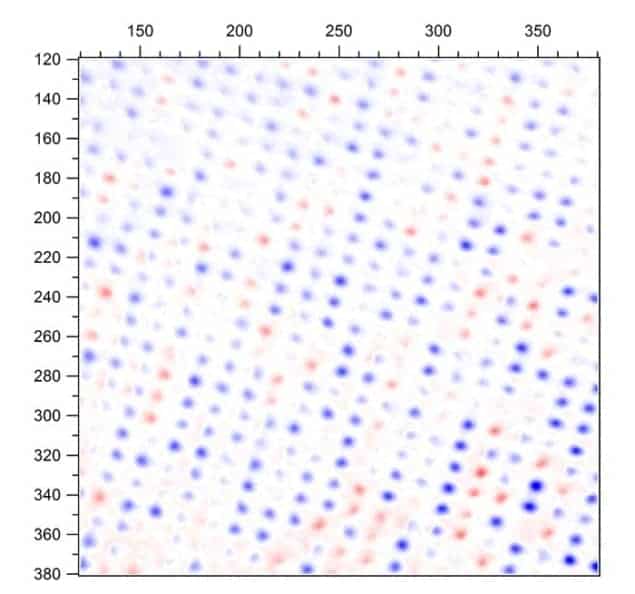
The interaction of nanoscale magnetic dipoles has been observed for the first time by researchers in Germany. Unexpectedly, the dipoles were seen to form chains, rather than the zigzag pattern expected from simple dipole interaction. The team believes this surprising outcome may be caused by higher-order interactions between the dipoles – a result that may have implications for the development of future hard-disk drives.
To set up their array of nanomagnets, the researchers, led by Hartmut Zabel, a physicist at the Ruhr-Universität Bochum, cut a regular square lattice from a thin magnetic iron-palladium film using electron beam lithography. The lattice was made up of circular islands, each a mere 150 nm in diameter. This alloy was chosen for its soft nature, as well as the potential to tune its Curie temperature – the temperature below which it becomes ferromagnetic – with varying iron concentrations. Ion beam sputtering was then used to remove the unwanted material from between the islands.
Straight lines or zigzags?
Above certain temperatures, thermal movements interfere with the interactions between small-scale magnetic dipoles. The experiments were therefore conducted at low temperatures, at which the orientation of the magnetic islands was based entirely on the interaction between each dipole. This allowed each of the islands to assume the most favourable orientation in terms of energy, a condition called the “ground state”. The researchers were able to observe the resulting pattern of dipole orientations using a photon emission electron microscope at the BESSY II electron synchrotron, at the Helmholtz-Zentrum Geesthach in Berlin. This machine uses X-ray photons to stimulate specific electrons within the target material, which provides information on the orientation of the dipoles being examined.
The team observed that the dipole islands formed a series of parallel and antiparallel chains – with adjacent islands’ north and south poles aligning to form the links in the chain – a result that was not anticipated. With each island having four neighbours to which it could have potentially aligned itself, one might expect a more random-looking zigzag pattern to result – as would be the case in purely simple dipole interactions.
“A magnetic dipole is an ideal mathematical construct working for point-like objects…It is also the dominant interaction in the far field,” says Zabel, adding that in the team’s case, “this type of ordering can only be understood via higher-pole interaction.” He explains that with closely spaced magnetic islands, higher-order relationships – such as quadrupolar and octopolar interactions – must become more important.
Next-generation drives
The results of this study are of great technical relevance to the development of next-generation hard-disk drives. Hard disks store digital data as a pattern of binary digits or bits. Today’s disks are made up of thin ferromagnetic films with opposing directions of magnetization used to encode the two bit states, “0” and “1”. Future disks, however, may use the orientation of tiny magnetic dipoles, similar to the ones examined in this study. To maximize the physical storage density, the ideal disk will use the smallest possible dipoles that can assume the two-bit-state orientations independently of each other. “Switching of the bits should be independent, but with [higher-order] interaction this may not be the case. Therefore it is important to study the magnetic interaction in regular patterns,” Zabel told physicsworld.com.
“[This] study aims at answering an important, fundamental question: how strong is the interaction between neighbouring nanomagnets and what is the nature of their interaction?” explains Axel Enders, an associate professor and nanostructure expert at the University of Nebraska, who was not involved in the work. “It turns out that simple textbook models based on dipolar interactions are insufficient to describe their experimental observations, calling for refinements of theoretical models and, of course, more experiments on the subject.”
While the team has now moved on to other areas of nanomagnetic research, Zabel also notes the great potential for continued study in this area. “There are many parameters to vary,” he comments, citing such possible variables as the island size and periodicity, iron concentration, which affects the Curie temperature, and the symmetry of the base lattice.
The work is published in Physical Review Letters.



